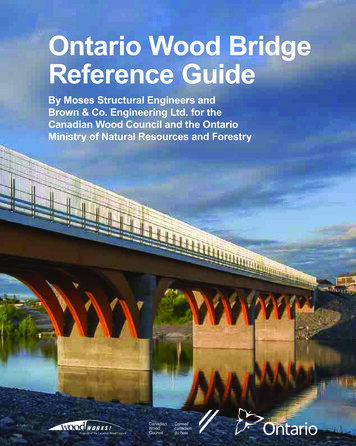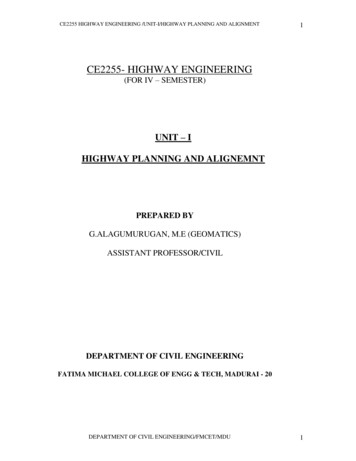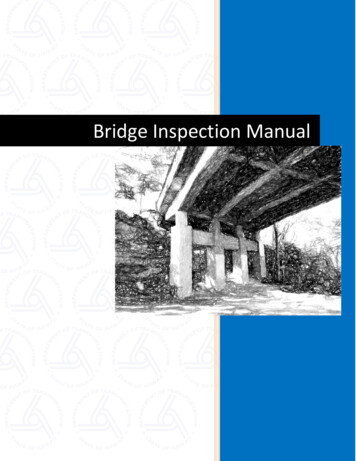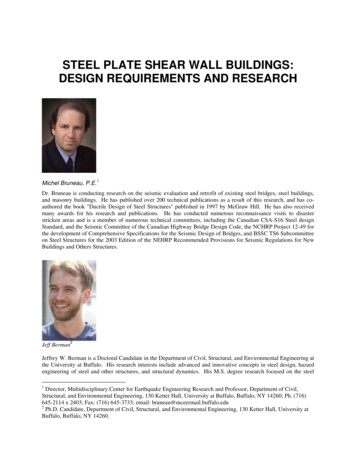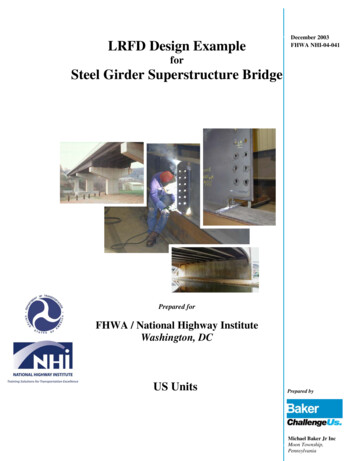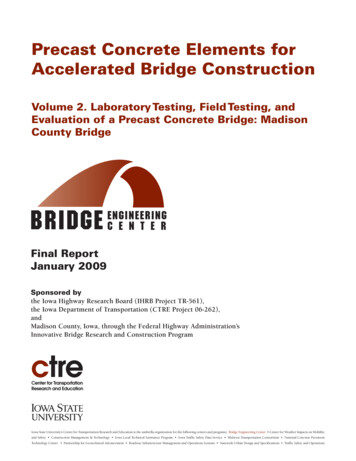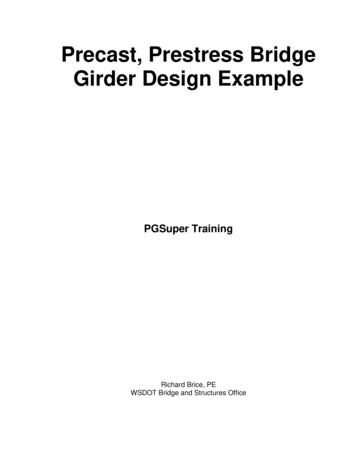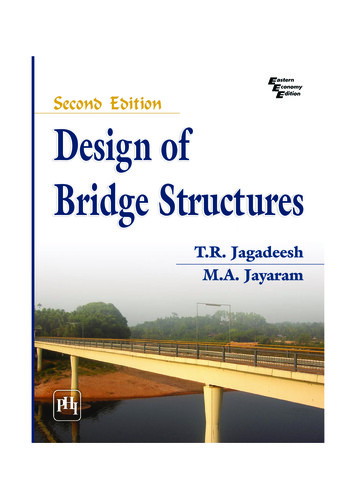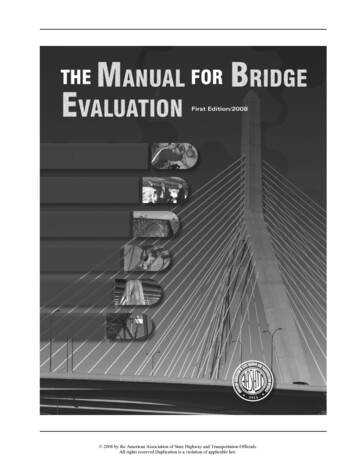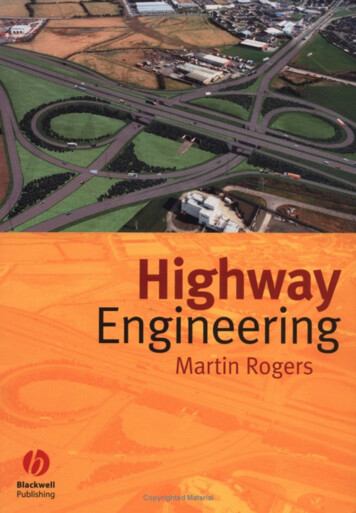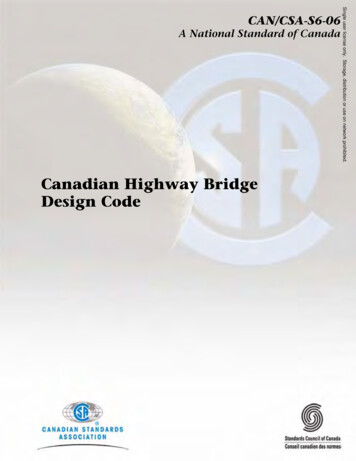
Transcription
A National Standard of CanadaCanadian Highway BridgeDesign CodeSingle user license only. Storage, distribution or use on network prohibited.CAN/CSA-S6-06
Single user license only. Storage, distribution or use on network prohibited.
Note: General Instructions for CSA Standards are now called Updates. Please contact CSA Information ProductsSales or visit www.ShopCSA.ca for information about the CSA Standards Update Service.Title: Canadian Highway Bridge Design Code — originally published November 2006The following revisions have been formally approved and are marked by the symbol delta ( ) in the marginon the attached replacement pages:RevisedTable of Contents, Clauses 1.2, 3.10.2.2, 3.10.5.2, A3.3.3.3.1, A3.3.3.3.3,4.4.7.1, 4.5.3.2, 4.7.4.3, Table of Contents (Section 5), 5.3.2, 5.7.1.6.1.1,5.7.1.7.1, 5.12.3, 8.4.4.6, 8.8.4.6, 8.9.3.18, 8.10.5.1, 8.14.6, 8.16.7.6.4.2,8.16.7.6.5, Table of Contents (Section 9), 9.6.1, 9.6.2, 9.8.1, 9.8.3.3, Table ofContents (Section 10), 10.3.2, 10.4.2, 10.4.5–10.4.7, 10.4.9, 10.4.11.2,10.5.3.2, 10.5.7, 10.5.9.2.4, 10.6.4.2, 10.6.6, 10.7, 10.7.1, 10.7.4.3, 10.8.1.3.1,10.8.1.3.2, 10.8.2, 10.9.3.1, 10.9.5.2, 10.9.5.4, 10.10.2.3, 10.10.8.1, 10.10.8.2,10.11.5.3.2, 10.11.6.3.1.2, 10.11.8.2, 10.11.8.3, 10.12.5.3.2, 10.12.5.4,10.13.6.1.2, 10.13.6.1.3, 10.13.7.3, 10.17.2.2, 10.17.2.3.2, 10.17.2.7,10.18.1.5, 10.18.2.3.1–10.18.2.3.3, 10.18.3.2.2, 10.19, 10.20.2.4, 10.22, 10.22.1–10.22.4, 10.23.3.5, 10.23.4.2–10.23.4.5, 10.24.3.2, 10.24.4.3.2,10.24.4.8, 10.24.5.1, 10.24.5.4–10.24.5.6, 10.24.7.2, 10.24.8.2, 10.24.9,Table of Contents (Section 14), 14.3, 14.5.2.1, 14.5.2.3, 14.5.4, 14.5.4.1, 14.6.2,14.6.4, 14.7.1, 14.7.4.3, 14.8.2.1, 14.9.3, 14.14.1.3.1, 14.14.1.3.2, 14.17.1,15.6.2.4, 16.3.2, 16.5.3, 16.6.2, 16.7.1–16.7.3, 16.8.4.1, 16.8.6.3, 16.8.7,16.8.8.1, 16.8.8.2, 16.10, 16.11.2.5.6, and 16.11.3.1–16.11.3.3, Tables 3.1,A3.1.1, 4.6, 5.4, 5.10, A5.2.2, 8.5, 9.15, 10.3, 10.9, 10.18, 13.3–13.5, 14.14,16.2, and 16.3, and Figures 5.1, 5.2, 5.3, 5.6, 10.1, 10.3, and 10.5NewTechnical Committee (membership at the time of the formal approval ofCSA S6S1-10), Subcommittees on Sections 3–6, 8, 10, 14, and 16 (membershipat the time of the formal approval of CSA S6S1-10), Code Calibration Task Force(membership at the time of the formal approval of CSA S6S1-10), FrenchTranslation Task Force (membership at the time of the formal approval ofCSA S6S1-10), Regulatory Authority Committee (membership at the time ofthe formal approval of CSA S6S1-10), Clauses 10.4.13, 10.5.3.6, 10.8.1.3.2.1–10.8.1.3.2.5, 10.11.8.3.1–10.11.8.3.3, 10.22.5–10.22.8,and 14.4.4, Tables 10.14A and 10.14B, and Figure 5.1ADeletedClauses 10.24.3.3, 10.24.3.4, 14.5.2.5, 14.5.3, and 14.9.5.6 and Table 10.14Single user license only. Storage, distribution or use on network prohibitedS6S1-10Supplement No. 1 to CAN/CSA-S6-06,Canadian Highway Bridge DesignCodeMay 2010
November 20061–6, 11–48, 51–60, 63, 64, 67–72, 75–104, 109–124, 127–130, 135, 136, 139–158, 161–164, 167–184, 189–192, 199–204, 207–210, 213–218, 221–316,319–326, 329–334, 337, 338, 341, 342, 345–352, 355–364, 367–380, 383–390,397–404, 407–424, 451, 452, 457–460, 463, 464, 475, 476, 481–486, 491–498,507, 508, 517, 518, 531–590, 595–640, 643, 644, 653–656, 661–664, 667–670,673–676, 679–690, 693–696, 701, 702, 707–710, 719, 720, and 725–733May 2010iiii–lxx, 7–10, 49, 50, 61, 62, 65, 66, 73, 74, 105–108, 125, 126, 131–134, 137,138, 159, 160, 165–166A, 185–188, 193–198, 205, 206, 211–212A, 219, 220,317, 318, 327, 328, 335, 336, 339, 340, 343, 344, 353, 354, 365, 366, 381,382, 391–396, 405, 406, 425– 450, 453– 456, 461, 462, 465– 474, 477– 480,487– 490, 499–506A, 509–516, 519–530, 591–594, 641, 642, 645–652, 657–660, 665, 666, 671, 672, 677, 678, 691, 692, 697–700, 703–706, 711–718,and 721–724 Update your copy by inserting these revised pages. Keep the pages you remove for reference.Single user license only. Storage, distribution or use on network prohibitedCAN/CSA-S6-06 originally consisted of 788 pages (lv preliminary and 733 text), each datedNovember 2006. It now consists of the following pages:
Supplement No. 1 to CAN/CSA-S6-06,Canadian Highway Bridge Design CodeContentsTechnical Committee on the Canadian Highway Bridge Design Code (CAN/CSA-S6-06) xxxTechnical Committee on the Canadian Highway Bridge Design Code (CSA S6S1-10) xxxiiSubcommittee on Section 1 — General xxxivSubcommittee on Section 2 — Durability xxxvSubcommittee on Section 3 — Loads (CAN/CSA-S6-06) xxxviSubcommittee on Section 3 — Loads (CSA S6S1-10) xxxviiSubcommittee on Section 4 — Seismic design (CAN/CSA-S6-06) xxxviiiSubcommittee on Section 4 — Seismic design (CSA S6S1-10) xxxixSubcommittee on Section 5 — Methods of analysis (CAN/CSA-S6-06) xlSubcommittee on Section 5 — Methods of analysis (CSA S6S1-10) xliSubcommittee on Section 6 — Foundations (CAN/CSA-S6-06) xliiSubcommittee on Section 6 — Foundations (CSA S6S1-10) xliiiSubcommittee on Section 7 — Buried structures xlivSubcommittee on Section 8 — Concrete structures (CAN/CSA-S6-06) xlvSubcommittee on Section 8 — Concrete structures (CSA S6S1-10) xlviSubcommittee on Section 9 — Wood structures xlviiSubcommittee on Section 10 — Steel structures (CAN/CSA-S6-06) xlviiiSubcommittee on Section 10 — Steel structures (CSA S6S1-10) xlixSubcommittee on Section 11 — Joints and bearings lSubcommittee on Section 12 — Barriers and highway accessory supports liSubcommittee on Section 13 — Movable bridges liiSubcommittee on Section 14 — Evaluation (CAN/CSA-S6-06) liiiSubcommittee on Section 14 — Evaluation (CSA S6S1-10) livSubcommittee on Section 15 — Rehabilitation and repair lvSubcommittee on Section 16 — Fibre-reinforced structures (CAN/CSA-S6-06) lviSubcommittee on Section 16 — Fibre-reinforced structures (CSA S6S1-10) lviiMay 2010(Replaces p. iii, November 2006)iiiSingle user license only. Storage, distribution or use on network prohibited Canadian Standards Association
Canadian Standards AssociationCode Calibration Task Force (CAN/CSA-S6-06) lixCode Calibration Task Force (CSA S6S1-10) lxEditorial Task Force lxiFrench Translation Task Force (CAN/CSA-S6-06) lxiiFrench Translation Task Force (CSA S6S1-10) lxiiiRegulatory Authority Committee (CAN/CSA-S6-06) lxivRegulatory Authority Committee (CSA S6S1-10) lxviPreface lxviiForeword lxxSection 1 — General 11.1Scope 21.1.1 Scope of Code 21.1.2 Scope of this Section 21.1.3 Terminology 21.2Reference publications 21.3Definitions 101.3.1 General 101.3.2 General administrative definitions 101.3.3 General technical definitions 101.3.4 Hydraulic definitions 151.4General requirements 161.4.1 Approval 161.4.2 Design 171.4.3 Evaluation and rehabilitation of existing bridges 181.4.4 Construction 181.5Geometry 201.5.1 Planning 201.5.2 Structure geometry 201.6Barriers 201.6.1 Superstructure barriers 201.6.2 Roadside substructure barriers 201.6.3 Structure protection in waterways 211.6.4 Structure protection at railways 211.7Auxiliary components 211.7.1 Expansion joints and bearings 211.7.2 Approach slabs 211.7.3 Utilities on bridges 211.8Durability and maintenance 221.8.1 Durability and protection 221.8.2 Bridge deck drainage 221.8.3 Maintenance 241.9Hydraulic design 251.9.1 Design criteria 251.9.2 Investigations 261.9.3 Location and alignment 261.9.4 Estimation of scour 26ivMay 2010(Replaces p. iv, November 2006)Single user license only. Storage, distribution or use on network prohibitedS6S1-10
1.9.51.9.61.9.71.9.81.9.91.9.101.9.11Supplement No. 1 to CAN/CSA-S6-06,Canadian Highway Bridge Design CodeProtection against scour 27Backwater 29Soffit elevation 29Approach grade elevation 30Channel erosion control 30Stream stabilization works and realignment 31Culverts 31Section 2 — Durability 332.1Scope 342.2Definitions 342.3Design for durability 342.3.1 Design concept 342.3.2 Durability requirements 342.3.3 Structural materials 362.4Aluminum 362.4.1 Deterioration mechanisms 362.4.2 Detailing for durability 362.5Polychloroprene and polyisoprene 372.6Polytetrafluoroethylene (PTFE) 372.7Waterproofing membranes 372.8Backfill material 372.9Soil and rock anchors 372.10Other materials 37Section 3 — Loads 393.1Scope 413.2Definitions 413.3Abbreviations and symbols 433.3.1 Abbreviations 433.3.2 Symbols 433.4Limit states criteria 473.4.1 General 473.4.2 Ultimate limit states 473.4.3 Fatigue limit state 473.4.4 Serviceability limit states 473.5Load factors and load combinations 483.5.1 General 483.5.2 Permanent loads 503.5.3 Transitory loads 513.5.4 Exceptional loads 513.6Dead loads 513.7Earth loads and secondary prestress loads 523.7.1 Earth loads 523.7.2 Secondary prestress effects 523.8Live loads 523.8.1 General 523.8.2 Design lanes 523.8.3 CL-W loading 523.8.4 Application 543.8.5 Centrifugal force 563.8.6 Braking force 563.8.7 Curb load 563.8.8 Barrier loads 563.8.9 Pedestrian load 57May 2010(Replaces p. v, November 2006)vSingle user license only. Storage, distribution or use on network prohibited Canadian Standards Association
.14.63.14.73.153.163.16.13.16.23.16.33.16.43.16.5 Canadian Standards AssociationMaintenance access loads 57Maintenance vehicle load 57Multiple-use structures 57Superimposed deformations 58General 58Movements and load effects 58Superstructure types 58Temperature effects 59Wind loads 61General 61Design of the superstructure 62Design of the substructure 63Aeroelastic instability 64Wind tunnel tests 65Water loads 65General 65Static pressure 65Buoyancy 65Stream pressure 65Wave action 66Scour action 66Debris torrents 66Ice loads 67General 67Dynamic ice forces 67Static ice forces 69Ice jams 69Ice adhesion forces 69Ice accretion 69Earthquake effects 69Vessel collisions 70General 70Bridge classification 70Assessment 70Annual frequency of collapse 70Design vessel 70Application of collision forces 70Protection of piers 71Vehicle collision load 71Construction loads and loads on temporary structures 71General 71Dead loads 71Live loads 71Segmental construction 71Falsework 72AnnexesA3.1 (normative)A3.2 (normative)A3.3 (normative)A3.4 (normative)— Climatic and environmental data 73— Wind loads on highway accessory supports and slender structural elements 94— Vessel collision 104— CL-625-ONT live loading 113Section 4 — Seismic design 1154.1Scope 1174.2Definitions 117viMay 2010(Replaces p. vi, November 2006)Single user license only. Storage, distribution or use on network prohibitedS6S1-10
104.10.114.10.124.10.13Supplement No. 1 to CAN/CSA-S6-06,Canadian Highway Bridge Design CodeAbbreviation and symbols 119Abbreviation 119Symbols 119Earthquake effects 122General 122Importance categories 122Zonal acceleration ratio 123Seismic performance zones 123Analysis for earthquake loads 123Site effects 125Elastic seismic response coefficient 126Response modification factors 127Load factors and load combinations 128Design forces and support lengths 128Analysis 132General 132Single-span bridges 132Multi-span bridges 133Foundations 134General 134Liquefaction of foundation soils 134Stability of slopes 135Seismic forces on abutments and retaining walls 135Soil-structure interaction 135Fill settlement and approach slabs 135Concrete structures 135General 135Seismic Performance Zone 1 135Seismic Performance Zone 2 136Seismic Performance Zones 3 and 4 136Piles 138Steel structures 140General 140Materials 140Sway stability effects 140Steel substructures 140Other systems 144Joints and bearings 144General 144Seismic design forces 144Seismic base isolation 144General 144Zonal acceleration ratio 145Seismic performance zones 145Site effects and site coefficient 145Response modification factors and design requirements for substructure 145Analysis procedures 145Clearance and design displacements for seismic and other loads 148Design forces for Seismic Performance Zone 1 148Design forces for Seismic Performance Zones 2, 3, and 4 148Other requirements 148Required tests of isolation system 149Elastomeric bearings — Design 151Elastomeric bearings — Construction 152May 2010(Replaces p. vii, November 2006)viiSingle user license only. Storage, distribution or use on network prohibited Canadian Standards Association
Canadian Standards 2.4Sliding bearings — Design 153Sliding bearings — Construction 153Seismic evaluation of existing bridges 153General 153Bridge classification 153Damage levels 153Performance criteria 153Evaluation methods 153Load factors and load combinations for seismic evaluation 154Minimum support length 154Member capacities 154Required response modification factor 155Response modification factor of existing substructure elements 155Evaluation acceptance criteria 155Other evaluation procedures 156Bridge access 156Liquefaction of foundation soils 156Soil-structure interaction 156Seismic rehabilitation 156Performance criteria 156Response modification factor for rehabilitation 156Seismic rehabilitation 156Seismic rehabilitation techniques .15 — Methods of analysis 159Scope 161Definitions 161Abbreviations and symbols 164Abbreviations 164Symbols 164General requirements 167Application 167Analysis for limit states 167Modelling 167Structural responses 167Factors affecting structural responses 170Deformations 170Diaphragms and bracing systems 170Analysis of deck slabs 171Analysis for redistribution of force effects 171Analysis for accumulation of force effects due to construction sequence 171Analysis for effects of prestress 171Analysis for thermal effects 171Secondary stability effects 171Requirements for specific bridge types 171General 171Voided slab — Limitation on size of voids 171Deck-on-girder 172Truss and arch 172Rigid frame and integral abutment types 172Transverse wood deck 172Box girder 172Single-spine bridges 173Dead load 173Simplified methods of analysis (beam analogy method) 173viiiMay 2010(Replaces p. viii, November 2006)Single user license only. Storage, distribution or use on network prohibitedS6S1-10
11.45.11.55.125.12.15.12.25.12.35.12.4Supplement No. 1 to CAN/CSA-S6-06,Canadian Highway Bridge Design CodeRefined methods of analysis 174Live load 174Simplified methods of analysis 174Refined methods of analysis 202Idealization of structure and interpretation of results 203General 203Effective flange widths for bending 203Idealization for analysis 207Refined methods of analysis for short- and medium-span bridges 207Selection of methods of analysis 207Specific applications 207Model analysis 207Long-span bridges 210General 210Cable-stayed bridges 210Suspension bridges 210Dynamic analysis 210General requirements of structural analysis 210Elastic dynamic responses 211Inelastic-dynamic responses 211Analysis for collision loads 211Seismic analysis 211Stability and magnification of force effects 212General 212Member stability analysis for magnification of member bending moments 212Structural stability analysis for lateral sway 212Structural stability analysis for assemblies of individual members 212AAnnexesA5.1 (normative) — Factors affecting structural response 213A5.2 (informative) — Two-dimensional analysis 217Section 6 — Foundations 2256.1Scope 2276.2Definitions 2276.3Abbreviations and symbols 2296.3.1 Abbreviations 2296.3.2 Symbols 2296.4Design requirements 2306.4.1 Limit states 2306.4.2 Effects on surroundings 2316.4.3 Effects on structure 2316.4.4 Components 2316.4.5 Consultation 2316.4.6 Inspection and quality control 2316.5Geotechnical investigation 2316.5.1 General 2316.5.2 Investigation procedures 2326.5.3 Geotechnical parameters 2326.5.4 Shallow foundations 2326.5.5 Deep foundations 2326.5.6 Report 2326.6Resistance and deformation 2336.6.1 General 2336.6.2 Ultimate limit state 233May 2010(Replaces p. ix, November 2006)ixSingle user license only. Storage, distribution or use on network prohibited Canadian Standards Association
136.13.16.13.2 Canadian Standards AssociationServiceability limit state 234Shallow foundations 235General 235Calculated geotechnical resistance at ULS 235Pressure distribution 237Effect of load inclination 238Factored geotechnical horizontal resistance 239Deep foundations 240General 240Selection of deep foundation units 240Vertical load transfer 240Downdrag 240Factored geotechnical axial resistance 240Group effects — Vertical loads 241Factored geotechnical lateral resistance 241Structural resistance 242Embedment and spacing 242Pile shoes and splices 243Lateral and vertical pressures 243General 243Lateral pressures 243Compaction surcharge 244Effects of loads 245Surcharge 245Wheel load distribution through fill 245Ground anchors 246Application 246Design 246Materials and installation 246Anchor testing 247Sheet pile structures 247Application 247Design 247Ties and anchors 248Cellular sheet pile structures 248MSE structures 248Application 248Design 248Backfill 249Pole foundations 249Application 249Design 249Section 7 — Buried structures 2517.1Scope 2527.2Definitions 2527.3Abbreviation and symbols 2547.3.1 Abbreviation 2547.3.2 Symbols 2547.4Hydraulic design 258Structural design 2597.57.5.1 Limit states 2597.5.2 Load factors 2607.5.3 Material resistance factors 2607.5.4 Geotechnical considerations 261xMay 2010(Replaces p. x, November 2006)Single user license only. Storage, distribution or use on network prohibitedS6S1-10
127.8.137.8.147.8.15Supplement No. 1 to CAN/CSA-S6-06,Canadian Highway Bridge Design CodeSeismic requirements 262Minimum clear spacing between conduits 262Soil-metal structures 263General 263Structural materials 265Design criteria 266Additional design requirements 271Construction 273Special features 275Site supervision and construction control 275Metal box structures 276General 276Structural materials 276Design criteria 277Additional design considerations 278Construction 278Special features 279Site supervision and construction control 279Reinforced concrete buried structures 279Standards for structural components 279Standards for joint gaskets for precast concrete units 280Installation criteria 280Loads and load combinations 287Earth pressure distribution from loads 288Analysis 291Ultimate limit state 291Strength design 292Serviceability limit state 295Fatigue limit state 295Minimum reinforcement 295Distribution reinforcement 296Details of the reinforcement 296Joint shear for top slab of precast concrete box sections with depth of cover less than 0.6 m 297Construction 297Section 8 — Concrete structures 3018.1Scope 3048.2Definitions 3048.3Symbols 3078.4Materials 3138.4.1 Concrete 3138.4.2 Reinforcing bars and deformed wire 3168.4.3 Tendons 3168.4.4 Anchorages, mechanical connections, and ducts 3178.4.5 Grout 3188.4.6 Material resistance factors 3188.5Limit states 3198.5.1 General 3198.5.2 Serviceability limit states 3198.5.3 Fatigue limit state 3198.5.4 Ultimate limit states 3208.6Design considerations 3208.6.1 General 3208.6.2 Design 3208.6.3 Buckling 323May 2010(Replaces p. xi, November 2006)xiSingle user license only. Storage, distribution or use on network prohibited Canadian Standards Association
4.68.158.15.18.15.28.15.38.15.48.15.5xii Canadian Standards AssociationPrestressing 323Stress limitations for tendons 323Concrete strength at transfer 324Grouting 324Loss of prestress 324Flexure and axial loads 326General 326Assumptions for the serviceability and fatigue limit states 326Assumptions for the ultimate limit states 327Flexural components 327Compression components 328Tension components 331Bearing 331Shear and torsion 331General 331Design procedures 332Sectional design model 333Slabs, walls, and footings 337Interface shear transfer 337Strut-and-tie model 338General 338Structural idealization 338Proportioning of a compressive strut 339Proportioning of a tension tie 340Proportioning of node regions 340Crack control reinforcement 340Durability 341Deterioration mechanisms 341Protective measures 341Detailing for durability 346Control of cracking 347General 347Distribution of reinforcement 347Reinforcement 347Crack control in the side faces of beams 348Flanges of T-beams 348Shrinkage and temperature reinforcement 348Deformation 348General 348Dimensional changes 349Deflections and rotations 349Details of reinforcement and special detailing requirements 350Hooks and bends 350Spacing of reinforcement 351Transverse reinforcement for flexural components 352Transverse reinforcement for compression components 352Reinforcement for shear and torsion 353Maximum spacing of reinforcement for shear and torsion 353Development and splices 353Development 353Development of reinforcing bars and deformed wire in tension 355Development of reinforcing bars in compression 356Development of pretensioning strand 357Development of standard hooks in tension 357May 2010(Replaces p. xii, November 2006)Single user license only. Storage, distribution or use on network prohibitedS6S1-10
23.18.23.28.23.38.23.48.23.58.23.68.23.7Supplement No. 1 to CAN/CSA-S6-06,Canadian Highway Bridge Design CodeCombination development length 358Development of welded wire fabric in tension 358Mechanical anchorages 358Splicing of reinforcement 358Anchorage zone reinforcement 360General 360Post-tensioning anchorage zones 360Pretensioning anchorage zones 363Inclined anchorages 363Intermediate anchorages 363Anchorage blisters 363Anchorage of attachments 363Seismic design and detailing 366Special provisions for deck slabs 367Design methods 367Minimum slab thickness 367Allowance for wear 367Empirical design method 367Diaphragms 370Edge stiffening 370Distribution reinforcement 370Composite construction 372General 372Flexure 372Shear 372Semi-continuous structures 372Concrete girders 373General 373Effective flange width for T- and box girders 373Flange thickness for T- and box girders 373Isolated girders 373Top and bottom flange reinforcement for cast-in-place T- and box girders 373Post-tensioning tendons 374Diaphragms 374Multi-beam decks 374Segmental construction 374General 374Additional ducts and anchorages 374Diaphragms 375Deviators for external tendons 375Coupling of post-tensioning tendons 375Special provisions for various bridge types 375Precast segmental beam bridges 377Concrete piles 378General 378Specified concrete strength 378Handling 378Splices 378Pile dimensions 378Non-prestressed concrete piles 378Prestressed concrete piles 379Section 9 — Wood structures 3819.1Scope 3849.2Definitions 384May 2010(Replaces p. xiii, November 2006)xiiiSingle user license only. Storage, distribution or use on network prohibited Canadian Standards Association
14.39.14.49.15xiv Canadian Standards AssociationSymbols 386Limit states 388General 388Serviceability limit states 388Ultimate limit states 388Resistance factor 388General design 389Design assumption 389Spans 389Load-duration factor 389Size-effect factors 389Service condition 389Load-sharing factor 389Notched components 390Butt joint stiffness factor 390Treatment factor 391Flexure 391Flexural resistance 391Size effect 391Lateral stability 392Shear 392Shear resistance 392Size effect 393Shear force and shear load 393Shear modulus 393Vertically laminated decks 393Compression members 393General 393Compressive resistance parallel to grain 394Slenderness effect 394Amplified moments 396Rigorous evaluation of amplified moments 396Approximate evaluation of amplified moments 398Tension members 399Compression at an angle to grain 400Sawn wood 401Materials 401Specified strengths and moduli of elasticity 401Glued-laminated timber 404Materials 404Specified strengths and moduli of elasticity 404Vertically laminated beams 405Camber 405Varying depth 405Curved members 406Structural composite lumber 406Materials 406Specified strengths and moduli of elasticity 406Wood piles 406Materials 406Splicing 406Specified strengths and moduli of elasticity 406Design 407Fastenings 407May 2010(Replaces p. xiv, November 2006)Single user license only. Storage, distribution or use on network prohibitedS6S1-10
19.25.2Supplement No. 1 to CAN/CSA-S6-06,Canadian Highway Bridge Design CodeGeneral 407Design 408Construction 408Hardware and metalwork 408Durability 408General 408Pedestrian contact 408Incising 408Fabrication 409Pressure preservative treatment of laminated veneer lumber 409Pressure preservative treatment of parallel strand lumber 409Field treatment 409Treated round wood piles 409Untreated round wood piles 409Pile heads 409Protective treatment of hardware and metalwork 409Stress-laminated timber decking 410Wood cribs 410General 410Member sizes and assembly 410Fastening 410Load transfer to cribs 410Wood trestles 411General 411Pile bents 411Framed bents 411Caps 411Bracing 411Stringers and girders 411Design details 411Diaphragms 412Nail-laminated wood decks 412General 412Transversely laminated wood decks 412Longitudinal nail-laminated wood decks 413Wood-concrete composite decks 413General 413Wood base 413Concrete slab 414Wood-concrete interface 415Factored moment resistance 416Stress-laminated wood decks 417General 417Post-tensioning materials 417Design of post-tensioning system 417Design of distribution bulkhead 419Laminated decks 421Net section 422Hardware durability 422Design details 423Wearing course 423Drainage 423General 423Deck 424May 2010(Replaces p. xv, November 2006)xvSingle user license only. Storage, distribution or use on network prohibited Canadian Standards Association
0.9.310.9.4xvi Canadian Standards Association10 — Steel structures 425Scope 428Definitions 428Abbreviations and symbols 430Abbreviations 430Symbols 430Materials 437General 437Structural steel 437Cast steel 437Stainless steel 438Bolts 438Welding electrodes 438Stud shear connectors 438Cables 438High-strength bars 438Galvanizing and metallizing 438Identification 438Coefficient of thermal expansion 439Pins and rollers 439Design theory and assumptions 439General 439Ultimate limit states 439Serviceability limit states 439Fatigue limit state 439Fracture control 440Seismic requirements 440Resistance factors 440Analysis 440Design lengths of members 440Durability 441General 441Corrosion as a deterioration mechanism 441Corrosion protection 441Superstructure components 441Other components 442Areas inaccessible after erection 444Detailing for durability 444Design details 444General 444Minimum thickness of steel 444Floor beams and diaphragms at piers and abutments 445Camber 445Welded attachments 446Tension members 446General 446Axial tensile resistance 447Axial tension and bending 447Tensile resistance of cables 447Compression members 447General 447Width-to-thickness ratio of elements in compression 448Axial compressive resistance 450Axial compression and bending 451May 2010(Replaces p. xvi, November 2006)Single user license only. Storage, distribution or use on network prohibitedS6S1-10
10.9.5 Composite columns 45310.10Beams and girders 45510.10.1 General 45510.10.2 Class 1 and 2 sections 45510.10.3 Class 3 sections 45710.10.4 Stiffened plate girders 45710.10.5 Shear resistance 45810.10.6 Intermediate transverse stiffeners 45910.10.7 Longitudinal web stiffeners 46010.10.8 Bearing stiffeners 46110.10.9 Lateral bracing, cross-frames, and diaphragms10.11Composite beams and girders 46310.11.1 General 46310.11.2 Proportioning 46310.11.3 Effects of creep and shrinkage 46310.11.4 Control of permanent deflections 46310.11.5 Class 1 and Class 2 sections 46310.11.6 Class 3 sections 46710.11.7 Stiffened plate girders 46910.11.8 Shear connectors 47010.11.9 Lateral bracing, cross-frames, and diaphragms10.12Composite box girders 47210.12.1 General 47210.12.2 Effective width of tension flanges 47210.12.3 Web plates
S6S1-10 Supplement No. 1 to CAN/CSA-S6-06, Canadian Highway Bridge Design Code May 2010 Note: General Instructions for CSA Standar ds are now called Upda tes.Please contact CSA Information Products Sales or visit www.ShopCSA.ca for information about the CSA Standards Update Service. Title: Canadian Hig
